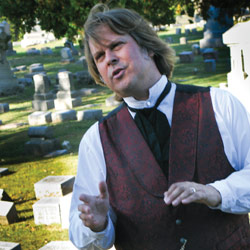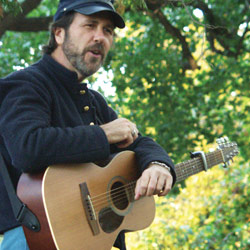Peoria’s Civil War Heroes

This spring will mark the sesquicentennial anniversary of the beginning of the Civil War. There is little doubt that men and boys from Illinois helped to win this war, from General Ulysses S. Grant at the helm to the hundreds of thousands of foot soldiers and cavalry men who fought under his command. Without much thought and almost every day, you probably drive on streets named for these veterans, who paid the ultimate price to preserve the Union.
The following are just a few of Peoria’s Civil War heroes who have been portrayed as part of Prairie Folklore Theatre’s annual Springdale Cemetery Tour.
Mathias Stritt
Stritt was born in Wurttemberg, Germany in 1821. His family immigrated to Wisconsin in 1830. When he was 40, he moved to Peoria to work for the Peoria Plow Works, where his skills in steel work were highly valued. When General Beauregard fired his cannons on Fort Sumter on April 1st, 1861, Mathias Stritt was the first to sign the rolls and the first in Peoria to enlist, joining the 11th cavalry.
He was wounded in battle, and returned home, where his wounds healed. In the 11th Regiment of the Illinois Calvary, 34 men were killed in action, but 245 died from disease and privation. These numbers were common—in most units, disease, exposure to the elements, gangrene and starvation killed more men than a musket ball. Of the 4.3 million men who formed a long line of bloody battle, more than half a million lost their lives and another half a million came back maimed for life. More Americans died in this “Un-Civil War” than both World War I and II combined, and a million widows, mothers, sisters and sweethearts mourned for those who did not return.
Stritt returned to Peoria, to his wife and children, and to his job at the Peoria Plow Works. Eventually, his lungs filled with emery dust from grinding steel. Consumption made breathing difficult, so he took his meager savings and opened a pub in Averyville. It became a place where veterans came to drown their sorrows, relive the glory days and lick their wounds. Soon, he helped create the Civil War Veterans group known as The Grand Army of the Republic and was one of the first to sign up for the GAR here in Peoria. He helped to found the Bryner Post No. 67, which later built the GAR Hall in downtown Peoria.
Robert Avery
Robert Avery was an inventor; the founder of Avery Company, a manufacturer of farm equipment; and mayor of Averyville. He was born on a farm just outside of Galesburg in January 1840.
He was 22 years old when he joined the 77th Illinois Infantry, which fought in the western theatre. He held a clerk’s job in Texas for the first year, before achieving the rank of sergeant and joining the fray in the Gulf of Mexico. Avery first saw action at the Battle of Mobile, where Admiral David Farragut shouted those now-famous words, “Damn the torpedoes, full steam ahead!” And it was here that Avery was captured by the Confederates and taken as a prisoner of war. He spent the rest of the war at the infamous Confederate prison in Andersonville, Georgia. The conditions were atrocious—45,000 men locked in with little food and no clean water or sanitation. Nearly 13,000 died miserable deaths, and those who survived were reduced to mere skeletons.
Avery heard the endless agonies of his prison mates and knew that he would be reduced to madness if he did not turn his mind to something hopeful. He began to draw pictures in the dirt, working out the details of a new invention, a horse-drawn cultivator. He would sketch each piece of the machine, and then build a model of this farm equipment using bits of twig.
When the war was over, he returned to Galesburg, where he worked with his younger brother, Cyrus, to create Avery Company. They bought 18 acres along the Illinois River on the north side of Peoria and built a state-of-the-art factory, forge and manufacturing facility in a village that later became known as Averyville, which elected Robert as its first mayor. At the company’s peak, it employed more than 4,000 men.
Colonel William Thrush
Little is known about Col. Thrush’s early life…It was as if everything led to one event: the Battle of Corinth on October 3rd, 1862.
Corinth was vital for one reason—five rail lines converged there—and that is why General Halleck led the Union troops to capture the town in May 1862. There was no single rebel position in the western theatre that was more important for the movement of troops and supplies.
But Confederate General P.G.T. Beauregard outfoxed Halleck by setting up dummies and keeping fires burning while his men slipped out of town at night. The Union forces captured Corinth with hardly a shot fired!
With rebel troops plotting to recapture the city, Thrush led his men all over Mississippi, chasing rebels from Jacinto and Luka to Bear Creek and Cane Creek, Alabama. Then, they marched back to Corinth through the heat and dust, arriving just as the Confederates attacked.
As they came close, the continuous roll of guns told them they were closing in on one big fight! The rebels were advancing on the Union brigade, and they were falling back, desperately seeking reinforcements. Although Col. Thrush’s men had just completed a 34-mile march, hurried orders came to advance immediately. Completely spent, Thrush replied, “The men are utterly exhausted. To move them faster will render them unfit for action.” Nonetheless, the roar of battle excited his men to quicken their steps and eventually break into a full run to the wild cheers of wounded soldiers.
The Eagle Brigade never had a warmer welcome, and upon meeting the line, the Confederate soldiers made it even hotter. Like bees buzzing in a hornet’s nest, the musket balls were flying! Giving it everything they had, the rebels were about to encircle the Union forces, but Thrush led a counterattack that swept the Confederate line back. Just as the cheering was swelling, and just as he turned the tide, he was shot and fell on the battlefield. He gave his life for the Union, but his men rallied the day. The Confederates fell back, and the following day they were routed, and Corinth was saved.
The strangest thing happened several months later, when Thrush’s sword, which had been taken on the battlefield when he was killed, was delivered to Mrs. Thrush by the U.S. Post. Col. Thrush was a mason, and the sword had been given to him by the Knights Templar. She thought that it was found by a Masonic brother who recognized the symbols on it, knew where it came from, and decided it should be returned to his family.
Thrush, the first major officer from Peoria to be killed in the war, is buried at Springdale Cemetery. His funeral procession was over a mile in length, not including the thousands of spectators that lined the streets. Joseph Henry Munroe
Joseph Henry Munroe
Joseph Henry Munroe was born in Boston, Massachusetts, in February 1849. His family moved to Burlington, Iowa, when he was four years old, and his father soon died. Banging on pots and pans with any sticks he could find, he began to fancy himself a drummer boy.
Munroe was only 12 years old when the War Between the States began, but he volunteered for the cause, marching with General Fremont, General Buell and General Grant. On a Sunday morning in April 1862, he found himself on the front lines of Shiloh, Tennessee, near a little church of that name. As the battle raged on, the Drummer Boy of Shiloh was captured by rebel forces and taken to the infamous prison in Andersonville.
Miraculously, he managed to escape. Rather than flee back home, he re-enlisted and served throughout the war, fighting in 27 major battles. After the war, he settled in Peoria, where he taught music at Peoria Central High School, led several fine orchestras and married Miss Anna Conrade of Peoria. They had a beautiful daughter, Marguerite. Munroe died in November of 1919, at the age of 70. iBi

